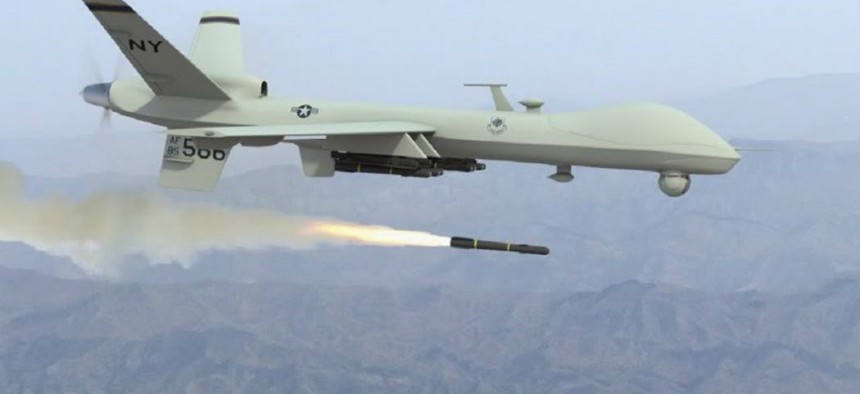Air Force counters ISIS explosive-laden drone attacks
Air Force ISR assets used electronic warfare to destroy two ISIS drones in combat.
Air Force intelligence analysts and operational leaders moved quickly to develop a new targeting combat plan to counter deadly ISIS explosive-laden drone attacks in Iraq and Syria.
In October of this year, ISIS used a drone, intended for surveillance use, to injure troops on the ground. Unlike typical surveillance drones, this one exploded after local forces picked it up for inspection, an Air Force statement said.
The emergence of bomb-drones, if even at times improperly used by ISIS, presents a new and serious threat to Iraqi Security Forces, members of the U.S.-Coalition and civilians, service officials explained to Defense Systems.
Commercial and military-configured drone technology has been quickly proliferating around the world, increasingly making it possible for U.S. enemies, such as ISIS, to launch drone attacks.
“Any attack against our joint or coalition warriors is a problem. Once it is identified, we get to work finding a solution. The resolve and ingenuity of the airmen in the 15th IS (intelligence squadron)” to protect our warriors, drove them to come up with a well-vetted solution within days,” Lt. Col. Jennifer S. Spires, 25th Air Force, a unit of the service dealing with intelligence, told Defense Systems.
Air Force officials explained that many of the details of the intelligence analysis and operational response to ISIS bomb-drones are classified and not available for discussion.
However, the service did explain elements of the effort, explaining that in October of this year, the Air Force stood up a working group to address the evolving threat presented by small commercial drones operated by ISIS, Erika Yepsen, Air Force spokeswoman, told Defense Systems.
Working intensely to address the pressing nature of the threat, Air Force intelligence analysts quickly developed a new Target Analysis Product to counter these kinds of ISIS drone attacks.
Specific tactics and combat solutions were made available to combatant commanders in a matter of days, service experts said.
“The working group cuts across functional areas and commands to integrate our best experts who have been empowered to act rapidly so they can continue to outpace the evolution of the threat they are addressing,” Yepsen said.
Personnel from the 15th IS, along with contributors, conducted a 280-plus hour rapid analysis drill to acquire over 40 finished intelligence products and associated single-source reports, Air Force commanders said.
While some analysts projected that developing a solution could take 11 to 12 weeks, the 15th IS personnel were able to cut that time by nearly 90 percent, Air Force officials said.
“While we cannot talk about the tactics and techniques that the 15th IS recommended, we can say that in every case, any targeting package sent to the air component adhered to rules that serve to protect non-combatants,” Spires added.
The 363rd Intelligence, Surveillance, and Reconnaissance Wing provides a targeting package in support of the Air Component.
“The supported command makes the final decision about when and how to strike a specific target. Once the theater receives the targeting package it goes into a strike list that the Combatant Commander prioritizes,” Spires said.
Also, Air Force Secretary Deborah James recently addressed an incident where two Air Force ISR assets were flying in support coalition ground operations when they were notified of a small ISIS drone in the vicinity of Mosul.
While James did not elaborate on the specifics of any electronic warfare techniques, these kinds of operations often involve the use of “electronic jamming” methods to interrupt or destroy the signal controlling enemy drones.
“The aircraft used electronic warfare capabilities to down the small drone in less than 15 minutes,” spokeswoman Yepsen told Defense Systems.
This phenomenon underscores a specific and important global combat trend, as the U.S. military increasingly tries to prepare for the growing reality that adversaries will rapidly have more sophisticated and deadly drone technologies.





